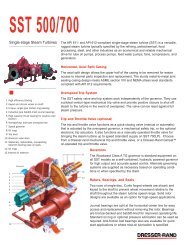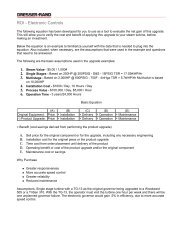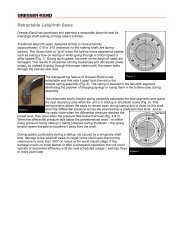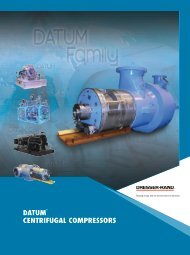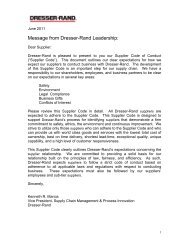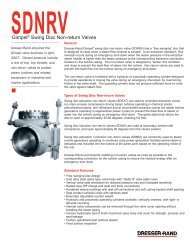Cogeneration Adds to Profits of Corn-Fed Ethanol - Dresser-Rand
Cogeneration Adds to Profits of Corn-Fed Ethanol - Dresser-Rand
Cogeneration Adds to Profits of Corn-Fed Ethanol - Dresser-Rand
Create successful ePaper yourself
Turn your PDF publications into a flip-book with our unique Google optimized e-Paper software.
<strong>Cogeneration</strong><br />
ADDS TO PROFITS<br />
<strong>of</strong> <strong>Corn</strong>-<strong>Fed</strong> <strong>Ethanol</strong> Plant<br />
PRACTICALLY SMACK DAB in the<br />
middle <strong>of</strong> the lower 48 states, trucks roll in<strong>to</strong><br />
Garnett, Kansas, 24 hours a day, every day, carrying<br />
thousands <strong>of</strong> bushels <strong>of</strong> corn. It may seem<br />
like a commonplace scene for this part <strong>of</strong> the<br />
U.S., but out the other end <strong>of</strong> the East Kansas<br />
Agri-Energy (EKAE) plant comes 125,000 gallons<br />
<strong>of</strong> pure ethanol, the environmentally<br />
friendly additive for au<strong>to</strong>motive gasoline.<br />
The manufacture <strong>of</strong> ethanol is an old technology<br />
dating back <strong>to</strong> antiquity when man first<br />
figured out how <strong>to</strong> distill fermented alcoholic<br />
beverages. But the EKAE plant in Garnett is<br />
completely modernized. “It's much like making<br />
corn mash whiskey,” says Kent Calvert, a<br />
sales engineer with Hughes Machinery<br />
Company, Wichita, Kansas, the <strong>Dresser</strong>-<strong>Rand</strong><br />
equipment representative who helped introduce<br />
a steam turbine genera<strong>to</strong>r at the plant. In<br />
addition <strong>to</strong> manufacturing ethanol, the plant<br />
generates approximately 750 kW <strong>of</strong> electricity.<br />
The EKAE plant, about 100 miles southwest <strong>of</strong><br />
Kansas City, operates around the clock 353 days<br />
a year (a dozen days are for scheduled maintenance<br />
outages), according <strong>to</strong> Doug Sommer,<br />
plant manager. Completed in June 2005, the<br />
$46.8 million plant is one <strong>of</strong> six ethanol plants<br />
in Kansas, and the first in the United States <strong>to</strong><br />
incorporate a steam turbine <strong>to</strong> generate electricity<br />
as part <strong>of</strong> its operation. EKAE, a farmer<br />
cooperative with more than 600 owner-members,<br />
decided during the design phase <strong>to</strong> add<br />
the steam turbine. The electrical generation<br />
represents a small portion <strong>of</strong> the coop's pr<strong>of</strong>its,<br />
and pr<strong>of</strong>itable it has been. The board authorized<br />
a first-year pr<strong>of</strong>it distribution <strong>of</strong> nearly<br />
$3.5 million among coop unit holders.<br />
Since the startup <strong>of</strong> the EKAE plant, new<br />
ethanol plant projects are taking up cogeneration<br />
as a sensible way <strong>to</strong> increase pr<strong>of</strong>its.<br />
As a gasoline additive, ethanol is both an efficient<br />
energy source and a clean burning renewable<br />
source. The demand is expected <strong>to</strong> skyrocket.<br />
It is replacing MTBE as a fuel additive<br />
throughout much <strong>of</strong> the United States.<br />
Currently cars can use a solution <strong>of</strong> 10 percent<br />
ethanol and 90 percent gasoline. In the industry<br />
this is referred <strong>to</strong> as E10. Most au<strong>to</strong> manufacturers<br />
are developing engines that will burn<br />
E85, or 85 percent ethanol. Cars in the 2007<br />
Indianapolis 500 will burn 100 percent ethanol.<br />
ICM, Inc., the Colwich, Kansas, engineering<br />
firm that designed the EKAE plant, was formed<br />
in 1995. During the past five years, ICM has<br />
been extremely active designing ethanol plants<br />
being built in the United States, according <strong>to</strong><br />
John Graham, the applications supervisor at<br />
<strong>Dresser</strong>-<strong>Rand</strong>'s steam turbine manufacturing<br />
Continued on page 8<br />
The EKAE ethanol plant in Garnett, Kansas, is the first in the U.S. <strong>to</strong> incorporate a steam<br />
turbine <strong>to</strong> generate electricity as part <strong>of</strong> its operation.<br />
7
facility in Burling<strong>to</strong>n, Iowa. The EKAE plant,<br />
however, was the first ICM plant in the U.S. <strong>to</strong><br />
employ cogeneration.<br />
“The fact that it's integrating a steam turbine<br />
genera<strong>to</strong>r set in<strong>to</strong> such an industry that's trying<br />
<strong>to</strong> be environmentally responsible is<br />
indicative <strong>of</strong> their forward thinking,” Calvert<br />
said. “The steam turbine genera<strong>to</strong>r is a technology<br />
that's been around for a long time,<br />
since the 1920s, and is being used in a new and<br />
innovative process. This plant was the first <strong>of</strong><br />
its kind.”<br />
In the U.S., ethanol is produced mostly from fermented<br />
grains. The EKAE plant uses 95 percent<br />
corn and the balance is sorghum. But ethanol<br />
can be produced by a variety <strong>of</strong> fermented grains<br />
and cellulosic sources such as post-harvest<br />
stalks, grain straw, switchgrass, and even<br />
municipal waste. (In Brazil, the world's largest<br />
ethanol producer uses sugar cane.)<br />
At EKAE the grain is milled, water is added, and<br />
the mixture is fermented with yeast. Following<br />
fermentation, the mash is distilled and eventually<br />
all water is removed, leaving pure ethyl<br />
alcohol. A natural gas-fired boiler is used for<br />
the distillation process. Steam is generated at<br />
120 psig, and for one part <strong>of</strong> the process it is<br />
controlled through a valve reducing the steam<br />
<strong>to</strong> atmospheric pressure. This is where the<br />
cogeneration occurs. “They have <strong>to</strong> drop the<br />
steam pressure anyway, why not make electricity?”<br />
Calvert said.<br />
This necessary pressure drop in the past had<br />
been a lost opportunity for ethanol producers,<br />
according <strong>to</strong> Ken Ulrich, the ICM design engineer<br />
who managed the EKAE account. The<br />
pressure drop means that electrical energy<br />
could be generated and used in the plant rather<br />
than buying from the grid. “We had been recommending<br />
this <strong>to</strong> clients for several years,”<br />
Ulrich said. “Their initial response had always<br />
8<br />
been, 'I don't want <strong>to</strong> be in the electrical industry,<br />
I just want <strong>to</strong> make ethanol. Why should I<br />
buy a turbine and genera<strong>to</strong>r when I can put in<br />
a control valve?'”<br />
That was the industry response until EKAE<br />
came along and <strong>to</strong>ok ICM, Hughes Machinery<br />
and <strong>Dresser</strong>-<strong>Rand</strong> up on their recommendation.<br />
EKAE saw a way <strong>to</strong> gain income from a<br />
steam turbine genera<strong>to</strong>r and be environmentally<br />
conscientious.<br />
The plant is using a <strong>Dresser</strong>-<strong>Rand</strong> model KD2<br />
steam turbine genera<strong>to</strong>r set, according <strong>to</strong><br />
Graham. The genera<strong>to</strong>r set produces 1600 kW<br />
<strong>of</strong> electricity using 120 psig inlet steam that's<br />
exhausting <strong>to</strong> atmospheric pressure.<br />
“I have <strong>to</strong> make the steam for the production<br />
process,” Ulrich explained. “This is a classic<br />
cogeneration application that's been around<br />
forever. It's nearly a perfect conversion <strong>of</strong> heat<br />
<strong>to</strong> work when you have an application where<br />
you use low-pressure exhaust steam.<br />
<strong>Cogeneration</strong> is extremely energy efficient.”<br />
Sommer, the plant manager, estimates the plant<br />
is saving $15,000 a month in electrical costs.<br />
<strong>Dresser</strong>-<strong>Rand</strong>, ICM, and Hughes Machinery all<br />
think the market for ethanol has just begun,<br />
and with it the demand for steam turbines and<br />
all the equipment needed <strong>to</strong> bring ethanol<br />
from the corn field <strong>to</strong> the gas station. While<br />
ethanol plant developers in the past had been<br />
hesitant <strong>to</strong> employ cogeneration, EKAE has<br />
shown that it is a viable solution, especially in<br />
areas with higher priced electricity. Since<br />
opening the plant in Garnett, Kansas, “we've<br />
gotten several more locations <strong>to</strong> install,” Ulrich<br />
<strong>of</strong> ICM said.<br />
Calvert <strong>of</strong> Hughes Machinery predicted that the<br />
ethanol plants <strong>of</strong> the future will become even<br />
more efficient as they embrace the new technologies.<br />
<strong>Ethanol</strong> production has grown from 1.63 billion<br />
gallons in 2000 <strong>to</strong> a predicted five billion<br />
gallons this year. It takes 34,000 BTUs <strong>of</strong> energy<br />
<strong>to</strong> turn corn in<strong>to</strong> ethanol, which <strong>of</strong>fers<br />
77,000 BTUs <strong>of</strong> energy. If the price <strong>of</strong> gasoline<br />
doesn't drop terribly low, the demand for<br />
ethanol is expected <strong>to</strong> continue its surge.<br />
“The boom is on,” said John Popek, <strong>Dresser</strong>-<br />
<strong>Rand</strong>'s regional manager based in Greensburg,<br />
Pennsylvania. “It has been compared <strong>to</strong> the<br />
petrochemical industry in the 1920s.” ■<br />
“I have <strong>to</strong> make the steam<br />
for the production process.<br />
This is a classic cogenera-<br />
tion application that’s been<br />
around forever."<br />
— Ken Ulrich,<br />
Design Engineer at ICM, Inc.<br />
In addition <strong>to</strong> manufacturing<br />
ethanol, the plant generates<br />
approximately 750 kW<br />
<strong>of</strong> electricity.





